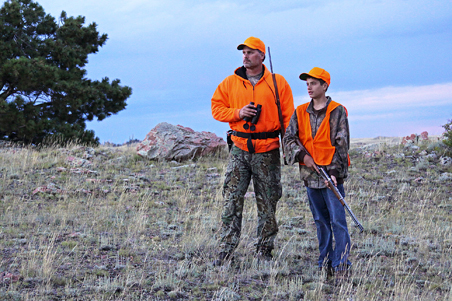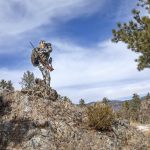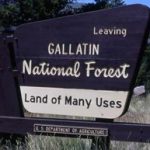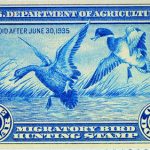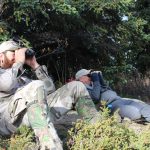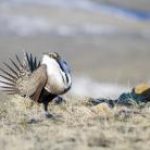Fewer young hunters entering the field has helped fuel a decline in hunting participation over the last five years. Photo by Vic Schendel
The decline in hunter numbers over the last five years is sparking concern about the funding model for wildlife conservation.
To quote the inimitable Gomer Pyle, “Surprise, surprise, surprise!” Who knewthat conservation in America is largely undergirded by hunters? Too few, apparently.
Unique to this continent is the North American Wildlife Conservation Model. Going back to the middle of the nineteenth century, hunters and anglers saw wildlife in crisis. There were virtually no game laws; and a large proportion of the population wanted to keep it that way to be able to exploit wildlife without restraint–or eliminate it and sweep the land clear for farmers and ranchers.
Far-sighted individuals, such as Theodore Roosevelt, who was first and foremost a hunter, witnessed the cascading destruction of the big game he loved so much to hunt in the West, leading him to found the Boone and Crockett Club, whose mission statement is “to promote the conservation and management of wildlife, especially big game, and its habitat, to preserve and encourage hunting and to maintain the highest ethical standards of fair chase and sportsmanship in North America.” With him at the founding of the Club were the most prominent conservations of the era, hunters all.
As Roosevelt came to power, he broughtwith him the Wildlife Model’s principals known as the Seven Sisters of Conservation: wildlife belongs to the people, government holding it in trust; market hunting must be outlawed by making it illegal to sell wild game meat; allocation of wildlife must be regulated by law; every citizen should have the freedom to hunt; wildlife was not to be wantonly wasted or mistreated; wildlife does not recognize borders, so migrating animals required the protection of international treaties; and decisions about wildlife must be based on the best science. And now we seem to be losing much of that wisdom.
Even before Roosevelt entered the White House, the Lacey Act, authored by Iowa Congressman John F. Lacey, another member of the Boone and Crockett Club, made it a federal offense to transport illegally taken wildlife across statelines and international borders. Upon assuming the executive office, Roosevelt turned to Lacey again to get through Congress the Antiquities Act, whichlet the president establish national monuments. Roosevelt also helped enactthe National Wildlife Refuge system. Later came migratory bird acts, in consort with Canada.
The U.S. hit upon a “user-play, user-pay” system for funding its wildlife conservation. The Pittman-Robertson Wildlife Restoration Act has,since 1937,taken the excise tax on firearms and ammunition and dedicated it to conservation, the amount distributed to wildlife agencies, along with the excise tax on angling equipment under the Dingell-Johnson Federal Aid in Sport Fish Restoration Act,together totaling some $19 billion, matched by $5 billion in state funds drawn from license and permit fees. And the Migratory Bird Hunting and Conservation Stamp (the “duck stamp”) has raised another $8 billion. Sixty percent of monies utilized by state wildlife agencies to manage this nation’s wildlife is drawn from these funds, along with license and permit fees. And these are all, it should be noted, voluntary payments from hunters, not tax dollars strong-armed by theI.R.S.
Not satisfied with, or entirely trusting in, a government-only approach, private hunter-conservation groups like the Rocky Mountain Elk Foundation (RMEF), Foundation for North American Wild Sheep (FNAWS), and Ducks Unlimited (DU), have pursued their own fundraising conservation projects in conjunction with state and federal agencies. The RMEF has opened, secured, or improved public access to more than 1.2 million acres of elk habitat; FNAWS puts nearly $5 million per year into conservation and other mission-program funding; while DU has conserved 11.6 million acres, and counting, of waterfowl habitat across North America. Wildlife conservation in our country has been a chiefly hunter-driven effort. And non-hunters are at last coming to recognize that, and worrying that it all may be about to end.
Every five years since 1955, the U.S. Census Bureau and the U.S. Fish and Wildlife Service haveissued aNational Survey of Fishing Hunting, & Wildlife-Associated Recreation. And between the current one and the previous, a decline of more than 2 million hunters in the country has been seen, enough to draw the attention of National Public Radio (NPR), in a recent broadcast segment.
Whether the weakened interest in hunting is real or perceived, we can take the numbers at face value. NPR recognized that this could have negative effects on wildlife conservation in this country, based on a withering of the wildly successful model that hasbeen fueling it for a century.
What may be the reasons for that? In NPR’s tallying, they arethe all-too usual ones: increased urbanization; restricted access to huntable areas; lack of free time; the rise of Netflix, video games, and all-consuming youth sports; and the erecting of a demographic wall as hunters “age out” starting around age sixty-five, and are not replaced by enough young hunters. How this affects funding for conservation, at least from the federal government, is that in order to secure Pittman-Robertson money, for example, state wildlife agencies must match at least a significant percentage–so reduced license and permit fees from a state’s hunters equates to reduced dollars from the feds.
NPR’s story offers solutions such as “change”and“evolve.”Suggestions for replacing hunter dollars include use of sales taxes, proposing legislation to redirect revenues from energy and mineral development on federal lands to state wildlife programs (tried before without success),and attempting to get “non-consumptive” users of wild lands–wildlife watchers and birders, along with hikers, campers, canoeists, etc.–to pay for the privilege of following their bliss by taxing equipment such as tents, sleeping bags, and optics.
Of the latter, efforts at it have never gone anywhere, thanks to the opposition of lobbygroupssuch as the Outdoor Industry Association, which represents such arch-druid environmentally correct companies as Patagonia. The shameful truth the industry and its consumers do not want to face is,as explained in a quote in the NPR piece from the Vermont Fish & Wildlife Department, wildlife viewing“provides no significant revenue stream to the department that would allow for the management of the resources viewed.”In cold cash, a wildlife watcher spends an average of $882 per year on his pastime. A hunter spends $2,237, demonstrating a much higherlevel of commitment.
If you want one more gauge of non-consumptive outdoorspeople’s eagerness to pay for the opportunity to see wildlife, consider what happened when the National ParkServiceproposedlast year to raise the seven-day entrance fee at some venues from $30 to $70 per vehicle. A typical response from an environmental group, the Outdoor Alliance for Kids, was to point to a bipartisan poll they commissioned showing an overwhelming majority of Americans believe our parks should remain open and available to all, whatever that means–in effect, no raise. Seventy dollars for admission for a carload of people for a week is thought to be an outrage against park visitors, yet how many of these balk at paying $103 for the least expensive child’s one-day admission ticket to Disney World’s Magic Kingdom?
The NPR piece skated around what is perhaps the main reason for the decline of hunters. Fifty or sixtyyears ago, hunterswere admired or at least tolerated (you could watch The American Sportsmanon network televison onSundays). At worst,we might be thought of as eccentric: Who sits hour upon hour in the woods, waiting for the appearance of lone animal? But that eccentricity proves the intrinsic worth of hunters when all their sedentariness might result in observations of the habitat and the wildlife that could advance the work of conservation, and that might not be noted by any other source. As long as hunters are in the forest, a falling tree will make a sound. (A concrete example of the critical expertise hunters possess through experience: When the government was reintroducing raptors in the 1970s, they needed to tap into the unique knowledge of veteran falconers who had never lost touch with the birds’ behaviors.)
For two generations, though (thank you,Dan Rather and “The Guns of Autumn”), American hunters have been openly, unabashedly, and relentlessly caricatured and vilified.Even today, it is impossible not to hear in words such as “clinging” and “deplorables” the thoughts of certain groups about hunters. For many of those who use that sort of language–primarily coastal elites–most of the land where hunting is still accepted is inhabited, according to them, by a kind of faceless, if not slack-jawed, wad of grubby hillbillies.
My use of the word “environmental” previously should be corrected. There was an implication that all environmentalists are anti-hunting, which is patently absurd. I am an environmentalist, and I hunt; and most, if not all, of the hunters I know are profoundly invested in the environment at well. Many environmentalists who do not hunt and likely never will nonetheless recognize the worth of hunters and hunting in maintaining the environment.
There are those, though–call them, what? enviro-progressives, animal-rights radicals?–who could with good conscience and righteous glee watch the last of a species vanish as long as it had not been hunted, even though hunting might have conserved it. Such sentiments are real and have their impact on the way hunters and hunting are perceived, coloring, if only tangentially, wildlife policy and discouraging, however vaguely, hunters from carrying on. Whatever the attitude of such ideologues, it does not represent the Seven Sisters principal that wildlife decisions must be based on the best science, rather thanonprejudice.
For all the innovative schemes suggested by NPR (which even they conclude are hardly likely to work), the strongest source of funding for conservation will remain hunters, who have the greatest, most personal stake in the wild and wildlife. A basic step in supporting them would be to view hunters with more respect than they currently receive. That should come as a surprise to no one.
Read the original NPR article at: https://www.npr.org/2018/03/20/593001800/decline-in-hunters-threatens-how-u-s-pays-for-conservation
Fewer young hunters entering the field has helped fuel a decline in hunting participation over the last five years.
Vic Schendel

